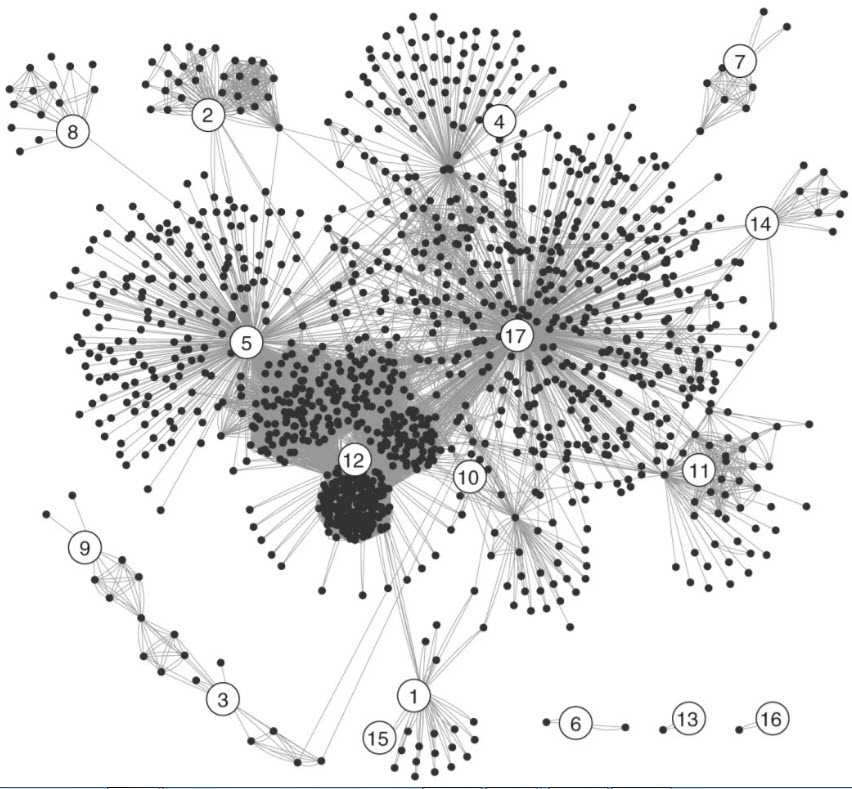A radical new holistic view of health based on cooperation and disease based on competition
September 16, 2013

A cytoscape analysis of all candidate genes identified at least twice and for which network information was available shows that many of the candidate genes are tightly linked to each other (credit: Marion Dejosez et al./Science)
Researchers at The Mount Sinai Medical Center have developed a radical holistic view of health — seeing it as a cooperative state among cells, while they see disease as result of cells at war that fight with each other for domination.
Their unique approach is backed by experimental evidence. The researchers show a network of genes in cells, which includes the powerful tumor suppressor p53, which enforce a cooperative state within cells — rather like the queen bee in a beehive.
Disease or disorder occurs when these enforcer genes are mutated, allowing competition between cells to ensue.
“Both competition and cooperation drive evolution, and we are wired for cooperation all the way down to our genes,” says the study’s senior investigator, Thomas P. Zwaka, MD, PhD, Professor at the Black Family Stem Cell Institute at the Icahn School of Medicine at Mount Sinai.
A new way to address disease
The findings, if backed by future research, offer a new way to address disease, Dr. Zwaka says. Understanding the genetic basis of cooperative and competitive cellular behaviors could explain how cancer and immune system dysfunction develops, he says.
“If a cell has lost a gene that fosters communication among cells, it may dominate other cells by ignoring signals to stop proliferating. It also makes sense that the immune system might detect and attack cells that are not cooperating. Failure to cooperate may also underlie development of birth defects.”
He adds that it may be possible to flip the cooperation switch back on therapeutically, or to manipulate stem-like cells to misbehave in a way that produces replacement cells for regenerative medicine.
“Cell misbehave, they are unpredictable. They do not operate like little machines,” he says. “What our study suggests is that cooperation is so central to our evolution that we have genetic mechanisms to protect us against cheating and dominating behavior.”
A network of genes with an ancient function
The research team, which also includes study first author Marion Dejosez, PhD, Assistant Professor at the Icahn School at Mount Sinai, took a long view toward the behavior of cells. They wondered how it was that cells, which lived on earth as single units for hundreds of millions of years, could effectively bundle themselves together to perform specific tasks. “Cells started somehow to form alliances, and to cooperate, and obviously this multicellularity had certain advantages.”
But they also questioned what happened to the “cheating” behavior that can be seen in single cells, such as amoeba, that live in colonies — competitive behavior that allows the cell to gain a reproductive advantage without contributing its fair share to the community.
They conducted a genetic screen in stem cells to look for mutants that allow cells to “misbehave — to become a little antisocial and do things they wouldn’t normally do,” Dr. Zwaka says. The screen picked up about 100 genes, which seem to cluster together into a network.
The team focused on three of those genes — p53, long known as the guardian of the genome, Topoisomerase 1 (Top1), which control genomic stability, and olfactory receptors involved in the sensation of smell.
Cooperation vs. competition
“We could understand that p53 might foster cooperation, because loss of p53 function is a step in the development of many cancers. But finding that top1 and olfactory receptors may have the same function was a surprise,” he says. “We think these genes have the ancient function of safeguarding multicellular organisms by helping cells to coordinate their activities.”
The scientists then tested the effects of knocking down these genes in developing mouse embryos. To their surprise, p53 and Top1 knockdown embryos developed normally — perhaps because other intact social enforcement genes took over.
“This showed us that mutant cells only misbehave when they are around normal cells. They become competitive, perhaps promoting an evolutionary advance,” Dr. Zwaka says. “When all the cells are the same, either all mutated or all normal, they cooperate with each other.
“This study suggests that cell cooperation, altruistic behavior, cheating, and other so-called social behaviors are wired into cells via the genome at the early primitive stage,” he says. “Perhaps there is no coincidence that amoeba, insects, animals, the human culture and society, generally follow innate rules of cooperation. Darwin’s explanation of evolution as a struggle for existence needs to be tempered with an acknowledgment of the importance of cooperation in the evolution of complexity.”
Working with Dr. Zwaka and Dr. Dejosez on the study were co-authors V. L. Brandt from the Black Family Stem Cell Institute, and Hiroki Ura, PhD, from Baylor College of Medicine in Houston.
The work was funded by the Huffington Foundation and by the National Institutes of Health.